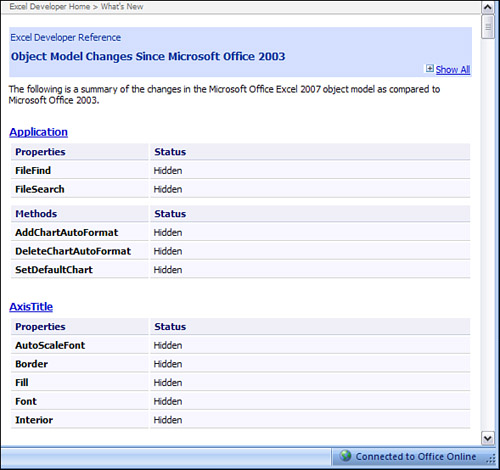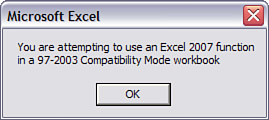Thankfully, not too much of VBA doesn’t work anymore, but a few things in the object model have changed. For most items, it’s obvious that, because the Excel user interface changed, the VBA has changed.
Note
The New graphic is used throughout the book to point out those sections discussing items that have changed from previous versions. For example, overall, names (discussed in Chapter 8) have not changed that much, but the Name Manager has changed, so there is a New graphic to bring your attention to this.
The Ribbon is one of the first changes you’ll notice when you open Excel 2007. Although the CommandBars object does still work to a point, if you want to flawlessly integrate your custom controls into the Ribbon, you need to make some major changes.
→ | See Chapter 26, “Customizing the Ribbon to Run Macros,” for more information. |
Charts have many new features that are not backward compatible with earlier versions of Excel. And although the macro recorder does record most of your actions on the Design and Layout ribbons, it won’t record action on the Format ribbon in the Format dialog boxes. This doesn’t mean the VBA code isn’t available; it’s just that you can’t learn it by recording it.
→ | See Chapter 11, “Creating Charts,” for more information. |
Pivot tables have a few new features available that aren’t backward compatible, such as subtotals at the top and the report layout options. Tables 13.1 and 13.2, in Chapter 13, “Using VBA to Create Pivot Tables,” list the new methods and properties in Excel 2007 that you have to watch out for if you need to make a backward-compatible workbook.
Conditional formatting has been completely reinvented. Where we were once limited to three conditions and changing a few cell formatting options, it seems now the sky’s the limit. To get an idea of how much this feature has changed, consider this: Special Edition Using Microsoft Office Excel 2007 (ISBN 0-7897-3611-X) has a 40-page chapter just to review the options available. Compare that to almost any Excel 2003 or earlier book, in which conditional formatting coverage was just a footnote or two scattered throughout the book. This feature has come a long way, which means so has the code. Compare the following two recorded macros. They both are relatively simple. A cell’s fill is changed to red if the value in the cell is between 1 and 5. Notice, however, how much more code is involved with the new options that you now need to set in 2007.
Excel 2003 recorded macro:
Sub Macro2()
'
' Macro2 Macro
'
'
Selection.FormatConditions.Delete
Selection.FormatConditions.Add Type:=xlCellValue, Operator:=xlBetween, _
Formula1:="1", Formula2:="5"
Selection.FormatConditions(1).Interior.ColorIndex = 3
ActiveCell.FormulaR1C1 = "2"
Range("A2").Select
End SubExcel 2007 recorded macro:
Sub Macro2()
'
' Macro2 Macro
'
'
Selection.FormatConditions.AddColorScale ColorScaleType:=2
Selection.FormatConditions(Selection.FormatConditions.Count).SetFirstPriority
Selection.FormatConditions(1).ColorScaleCriteria(1).Type = _
xlConditionValueNumber
Selection.FormatConditions(1).ColorScaleCriteria(1).Value = 1
With Selection.FormatConditions(1).ColorScaleCriteria(1).FormatColor
.Color = 255
.TintAndShade = 0
End With
Selection.FormatConditions(1).ColorScaleCriteria(2).Type = _
xlConditionValueNumber
Selection.FormatConditions(1).ColorScaleCriteria(2).Value = 5
With Selection.FormatConditions(1).ColorScaleCriteria(2).FormatColor
.Color = 255
.TintAndShade = 0
End With
ActiveCell.FormulaR1C1 = "2"
Range("A2").Select
End SubTables are a convenient way to deal with data that is already set up as tables (multiple records set up beneath a row of column headers). For this new functionality, there are corresponding new objects, properties, and methods.
Because of the increased sorting options (such as sorting by color), sort code has gone through a few changes. Instead of a single line of code with a few options to set, you need to configure the sort options and then do the sort, as shown here:
Sub Macro2()
'
' Macro2 Macro
'
'
Range("A1:A4").Select
'clear current sort options
ActiveWorkbook.Worksheets("Sheet1").Sort.SortFields.Clear
'set the new sort option - this is just a simple A-Z sort
ActiveWorkbook.Worksheets("Sheet1").Sort.SortFields.Add Key:=Range("A1"), _
SortOn:=xlSortOnValues, Order:=xlAscending, DataOption:=xlSortNormal
'do the actual sort
With ActiveWorkbook.Worksheets("Sheet1").Sort
.SetRange Range("A1:A4")
.Header = xlYes
.MatchCase = False
.Orientation = xlTopToBottom
.SortMethod = xlPinYin
.Apply
End With
End SubThere is one glaring negative change to VBA. Actions that were once recordable aren’t. For example, in Excel 2003, you could record the insertion of a text box and some text on a sheet and get the following (slightly modified to fit this page):
Sub Macro1()
'
' Macro1 Macro
'
'
ActiveSheet.Shapes.AddTextbox(msoTextOrientationHorizontal, 268.5, 178.5, _
116.25, 145.5).Select
Selection.Characters.Text = _
"This is a test of inserting a text box to a sheet and adding some text." & _
"This is a test of inserting a text box to a sheet and adding some text." & _
"This is a test of inserting a text box to a sheet and ad"
Selection.Characters(201).Insert String:="ding some text. "
With Selection.Characters(Start:=1, Length:=216).Font
.Name = "Arial"
.FontStyle = "Regular"
.Size = 10
.Strikethrough = False
.Superscript = False
.Subscript = False
.OutlineFont = False
.Shadow = False
.Underline = xlUnderlineStyleNone
.ColorIndex = xlAutomatic
End With
Range("I15").Select
End SubTry the same thing in Excel 2007, and you get this:
Sub Macro1()
'
' Macro1 Macro
'
Selection.Copy
ActiveSheet.Paste
ActiveSheet.Paste
Range("I5").Select
End SubNot very useful at all—the recorder is ignoring the existance of the text box! However, it doesn’t mean you can’t use VBA to add a text box—it’s just a little harder to figure out how to make it do what you want.
To figure out how to make it work, I typed textbox in the VB Editor Help and selected AddTextbox Method from the list of articles. From there, I modified the required parts of the Excel 2003 code that I had previously recorded, which consisted of changing how the text box and its text is added, and then came up with the following:
Sub AddTextBox()
ActiveSheet.Shapes.AddTextBox(msoTextOrientationHorizontal, 268.5, 178.5, _
116.25, 145.5).TextFrame.Characters.Text = _
"This is a test of inserting a text box to a sheet and adding some text." & _
"This is a test of inserting a text box to a sheet and adding some text." & _
"This is a test of inserting a text box to a sheet and adding some text."
With Selection.Characters(Start:=1, Length:=216).Font
.Name = "Arial"
.FontStyle = "Regular"
.Size = 10
.Strikethrough = False
.Superscript = False
.Subscript = False
.OutlineFont = False
.Shadow = False
.Underline = xlUnderlineStyleNone
.ColorIndex = xlAutomatic
End With
Range("I15").Select
End SubExcel’s VBA Help files have several tables of changes for objects and methods in Excel that you can refer to. They’re even broken up by version number, as shown in Figure 7.1. To access these tables, click the Help icon in the VB Editor toolbar and select What’s New from the dialog that appears.
When you review the “Object Model Changes Since ...” sections, you may be wondering what Microsoft means when they say an item’s status is Hidden (see Figure 7.2). If you use one of these items in your code, such as FileSearch, the program will compile just fine, but it won’t run in Excel 2007. Microsoft has allowed you to include the item in your code for legacy usage and will compile it, but when you try to run it, the program won’t know what to do with it. Unless you have some kind of compatibility mode check in your code, your program will debug at runtime.
With all the changes in Excel 2007, now more than ever it’s important to verify the application’s version. Two ways you can do this are Version and Excel8CompatibilityMode.
The Version property returns a string containing the active Excel application version. For 2007, this is 12. This can prove useful if you’ve developed an add-in to use across versions; but some parts of it, such as saving the active workbook, are version specific:
Sub wkbkSave()
Dim xlVersion As String
Dim myxlOpenXMLWorkbook As String
myxlOpenXMLWorkbook = "51"
xlVersion = Application.Version
Select Case xlVersion
Case Is = "9.0", "10.0", "11.0"
ActiveWorkbook.SaveAs Filename:="LegacyVersionExcel.xls"
Case Is = "12.0"
ActiveWorkbook.SaveAs Filename:="Excel2007Version", _
FileFormat:=myxlOpenXMLWorkbook
End Select
End SubNote that for the FileFormat property of the Excel 2007 case, I had to create my own variable, myxlOpenXMLWorkbook, to hold the constant value of xlOpenXMLWorkbook. If I were to try to run this in an earlier version of Excel just using the Excel 2007 constant, xlOpenXMLWorkbook, the code would not even compile.
This property returns a Boolean, to let you know whether a workbook is in Compatibility mode—that is, saved as an Excel 97-2003 file. You use this, for example, if you have an add-in using the new conditional formatting, but you wouldn’t want the user to try and use it on the workbook. The following function, CompatibilityCheck, returns True if the active workbook is in Compatibility mode and False if it is not. The procedure, CheckCompatibility, uses the result to inform the user of an incompatible feature, as shown in Figure 7.3:
Function CompatibilityCheck() As Boolean
Dim blMode As Boolean
If Application.Version = "12.0" Then
blMode = ActiveWorkbook.Excel8CompatibilityMode
If blMode = True Then
CompatibilityCheck = True
ElseIf blMode = False Then
CompatibilityCheck = False
End If
End If
End Function
Sub CheckCompatibility()
Dim xlCompatible As Boolean
xlCompatible = CompatibilityCheck
If xlCompatible = True Then
MsgBox "You are attempting to use an Excel 2007 function " & Chr(10) & _
"in a 97-2003 Compatibility Mode workbook"
End If
End Sub


